Evidence for anorthositic crust formed on an inner solar system planetesimal
Affiliations | Corresponding Author | Cite as | Funding information- Share this article





Article views:2,966Cumulative count of HTML views and PDF downloads.
- Download Citation
- Rights & Permissions
top
Abstract
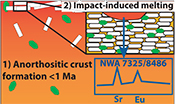
Lee, T., Papanastassiou, D., Wasserburg, G. (1977) Aluminum-26 in the early solar system-Fossil or fuel. Astrophysical Journal 211, L107-L110.
). To date, the only known anorthositic crust on a solar system body is that of the Moon, formed by plagioclase flotation on top of the magma ocean (Wood et al., 1970Wood, J.A., Dickey Jr, J., Marvin, U.B., Powell, B. (1970) Lunar anorthosites and a geophysical model of the moon. Geochimica et Cosmochimica Acta Supplements 1, 965-988.
). Here we show evidence from the ungrouped achondrite meteorite Northwest Africa (NWA) 8486 that an anorthositic crust formed on a planetesimal very early in solar system history (<1.7 Ma). NWA 8486 displays the highest anomalies in Eu and Sr found in achondrites so far and, for the first time, this characteristic is also identified in clinopyroxene. Elemental modelling, together with calculated timescales for crystal settling, show that only the melting of an anorthosite can produce NWA 8486 within the first 5 million years of solar system history. Our results indicate that such a differentiation scenario was achievable over short timescales within the inner solar system, and must have contributed to the making and elemental budget of the terrestrial planets.Figures and Tables
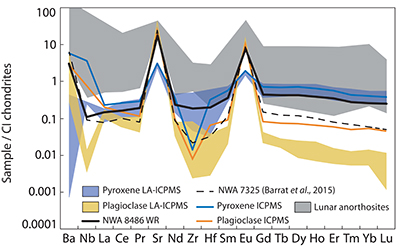 Figure 1 Trace element composition of NWA 8486 normalised to CI chondrites (Anders and Grevesse, 1989). All fractions exhibit Eu and Sr positive anomalies. NWA 7325 has a lower content for most incompatible elements compared to NWA 8486 owing to its modal enrichment in plagioclase. Lunar anorthosites are reported for comparison (data from Haskin et al., 1973 and Norman et al., 2003). | 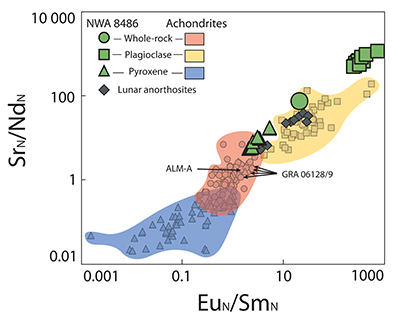 Figure 2 Eu/Sm and Sr/Nd ratios of achondrites and NWA 8486 normalised to CI chondrites (Anders and Grevesse, 1989). Overlap between the different fields is due to whole rocks mainly composed of pyroxene or plagioclase (e.g., aubrites, ureilites, lunar anorthosites). For each field group, NWA 8486 exhibits higher EuN/SmN and SrN/NdN. Only lunar anorthosites are similar to NWA 8486 whole rock, but they contain much more plagioclase than NWA 8486. See Supplementary Information for data sources. | 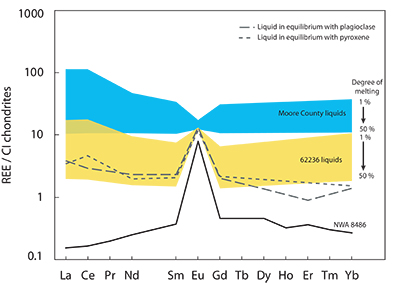 Figure 3 REE composition of liquids in equilibrium with NWA 8486 minerals (in grey dashed lines) compared to liquids modelled with compositions of the cumulate eucrite Moore County and the pyroxene-rich lunar anorthosite Apollo 62236, normalised to CI chondrites (Anders and Grevesse, 1989). A non-modal melting is considered, in agreement with petrological constraints, of eutectic proportions of 42 % plagioclase and 58 % pyroxene (Osborn, 1942). The range of composition of the liquids from 1 % to 50 % degree of melting is represented for each source composition. NWA 8486 whole rock composition is shown (black line) for comparison. See Supplementary Information for details on the model. |  Figure 4 Time for plagioclase crystal ascent during the late stage of a magma ocean. This time is calculated for a range of viscosities (0.1 to 10 Pa.s), crystal diameters (a; 100 µm to 1 cm) and density contrasts (∆ρ; 50 to 500 kg/m3) between the crystal and the liquid phase. The time for a crystal to reach the surface of the magma ocean is represented with a colour scale ranging between 10 kyr (blue) and 2 Myr (red). Both panels show that the time of ascent of the crystal is a few tens of thousands of years in magma ocean conditions, except for small crystals around 100 µm and high viscosities of >10 Pa.s for which time of ascent is longer. |
| Figure 1 | Figure 2 | Figure 3 | Figure 4 |
top
Introduction
Over 80 ungrouped achondrites have been found in the past 20 years, enriching our collections with new types of meteoritic samples. Northwest Africa (NWA) 8486 is one of several paired stones, along with the ungrouped achondrites NWA 7325 and 8014, that have been found in the Sahara desert (Ruzicka et al., 2017
Ruzicka, A., Grossman, J., Bouvier, A., Agee, C.B. (2017) The Meteoritical Bulletin, No. 103. Meteoritics and Planetary Science 52, 1014.
). They are plagioclase-rich cumulative gabbros that experienced remelting and fast cooling (Yang et al., 2019Yang, J., Zhang, C., Miyahara, M., Tang, X., Gu, L., Lin, Y. (2019) Evidence for early impact on hot differentiatied plantesimal from Al-rich micro-inclusions in ungrouped achondrite Northwest Africa 7325. Geochimica et Cosmochimica Acta 258, 310-335.
), with a very peculiar calcic and magnesian mineralogy. NWA 8486 formed under reduced conditions, with an oxygen fugacity (fO2) of 3.2 log units below the iron-wüstite (IW) buffer (Sutton et al., 2017Sutton, S.R., Goodrich, C.A., Wirick, S. (2017) Titanium, Vanadium and Chromium Valences in Silicates of Ungrouped Achondrite (NWA) 7325 and Ureilite Y-791538 Record Highly-Reduced Origins. Geochimica et Cosmochimica Acta 204, 313-330.
), and therefore likely originates from the inner solar system. Based on Cr, Ti and O isotopic compositions, NWA 7325/8486 have affinities with both acapulcoite-lodranite and ureilite groups (Barrat et al., 2015Barrat, J.-A., Greenwood, R.C., Verchovsky, A.B., Gillet, P., Bollinger, C., Langlade, J.A., Liorzou, C., Franchi, I.A. (2015) Crustal differentiation in the early solar system: Clues from the unique achondrite Northwest Africa 7325 (NWA 7325). Geochimica et Cosmochimica Acta 168, 280-292.
; Weber et al., 2016Weber, I., Morlok, A., Bischoff, A., Hiesinger, H., Ward, D., Joy, K., Crowther, S., Jastrzebski, N., Gilmour, J., Clay, P. (2016) Cosmochemical and spectroscopic properties of Northwest Africa 7325—A consortium study. Meteoritics and Planetary Science 51, 3-30.
; Goodrich et al., 2017Goodrich, C.A., Kita, N.T., Yin, Q.-Z., Sanborn, M.E., Williams, C.D., Nakashima, D., Lane, M.D., Boyle, S. (2017) Petrogenesis and Provenance of Ungrouped Achondrite Northwest Africa 7325 from Petrology, Trace Elements, Oxygen, Chromium and Titanium Isotopes, and Mid-IR Spectroscopy. Geochimica et Cosmochimica Acta 203, 381-403.
). The Pb-Pb isochron age of 4563.4 ± 2.6 Ma, Al–Mg age of 4563.09 ± 0.26 Ma and initial Mg isotopic composition for NWA 7325 indicate that the parent material of this meteorite had to be formed within 1-2 Myr after Solar System formation (Koefoed et al., 2016Koefoed, P., Amelin, Y., Yin, Q.-Z., Wimpenny, J., Sanborn, M.E., Iizuka, T., Irving, A.J. (2016) U–Pb and Al–Mg systematics of the ungrouped achondrite Northwest Africa 7325. Geochimica et Cosmochimica Acta 183, 31-45.
).top
Eu and Sr Anomalies in NWA 7325/8486
We investigated major and trace element composition of NWA 8486 through in situ and in solution analyses. The mineral compositions of NWA 8486 are consistent with those of NWA 7325 (Barrat et al., 2015
Barrat, J.-A., Greenwood, R.C., Verchovsky, A.B., Gillet, P., Bollinger, C., Langlade, J.A., Liorzou, C., Franchi, I.A. (2015) Crustal differentiation in the early solar system: Clues from the unique achondrite Northwest Africa 7325 (NWA 7325). Geochimica et Cosmochimica Acta 168, 280-292.
; Weber et al., 2016Weber, I., Morlok, A., Bischoff, A., Hiesinger, H., Ward, D., Joy, K., Crowther, S., Jastrzebski, N., Gilmour, J., Clay, P. (2016) Cosmochemical and spectroscopic properties of Northwest Africa 7325—A consortium study. Meteoritics and Planetary Science 51, 3-30.
; Goodrich et al., 2017Goodrich, C.A., Kita, N.T., Yin, Q.-Z., Sanborn, M.E., Williams, C.D., Nakashima, D., Lane, M.D., Boyle, S. (2017) Petrogenesis and Provenance of Ungrouped Achondrite Northwest Africa 7325 from Petrology, Trace Elements, Oxygen, Chromium and Titanium Isotopes, and Mid-IR Spectroscopy. Geochimica et Cosmochimica Acta 203, 381-403.
), with An88.7±3.0Ab11.2±3.0 plagioclase, Wo45.4±0.5En53.4±0.5Fs1.2±0.1 clinopyroxene and Fo97.1±0.3 olivine. The modal compositions reported for different fragments of NWA 7325 vary (Barrat et al., 2015Barrat, J.-A., Greenwood, R.C., Verchovsky, A.B., Gillet, P., Bollinger, C., Langlade, J.A., Liorzou, C., Franchi, I.A. (2015) Crustal differentiation in the early solar system: Clues from the unique achondrite Northwest Africa 7325 (NWA 7325). Geochimica et Cosmochimica Acta 168, 280-292.
; Weber et al., 2016Weber, I., Morlok, A., Bischoff, A., Hiesinger, H., Ward, D., Joy, K., Crowther, S., Jastrzebski, N., Gilmour, J., Clay, P. (2016) Cosmochemical and spectroscopic properties of Northwest Africa 7325—A consortium study. Meteoritics and Planetary Science 51, 3-30.
; Goodrich et al., 2017Goodrich, C.A., Kita, N.T., Yin, Q.-Z., Sanborn, M.E., Williams, C.D., Nakashima, D., Lane, M.D., Boyle, S. (2017) Petrogenesis and Provenance of Ungrouped Achondrite Northwest Africa 7325 from Petrology, Trace Elements, Oxygen, Chromium and Titanium Isotopes, and Mid-IR Spectroscopy. Geochimica et Cosmochimica Acta 203, 381-403.
), illustrating the heterogeneous distribution of the minerals at the centimetre scale. The fragment of NWA 8486 studied here contains the highest pyroxene modal content at 52 %, the lowest plagioclase content at 44 %, with the remaining 4 % consisting of olivine, sulphides and metal. The range reported for NWA 7325 is 30-44 % for pyroxene, 54-60 % for plagioclase and 2-15 % for olivine (Barrat et al., 2015Barrat, J.-A., Greenwood, R.C., Verchovsky, A.B., Gillet, P., Bollinger, C., Langlade, J.A., Liorzou, C., Franchi, I.A. (2015) Crustal differentiation in the early solar system: Clues from the unique achondrite Northwest Africa 7325 (NWA 7325). Geochimica et Cosmochimica Acta 168, 280-292.
; Weber et al., 2016Weber, I., Morlok, A., Bischoff, A., Hiesinger, H., Ward, D., Joy, K., Crowther, S., Jastrzebski, N., Gilmour, J., Clay, P. (2016) Cosmochemical and spectroscopic properties of Northwest Africa 7325—A consortium study. Meteoritics and Planetary Science 51, 3-30.
; Goodrich et al., 2017Goodrich, C.A., Kita, N.T., Yin, Q.-Z., Sanborn, M.E., Williams, C.D., Nakashima, D., Lane, M.D., Boyle, S. (2017) Petrogenesis and Provenance of Ungrouped Achondrite Northwest Africa 7325 from Petrology, Trace Elements, Oxygen, Chromium and Titanium Isotopes, and Mid-IR Spectroscopy. Geochimica et Cosmochimica Acta 203, 381-403.
).We report trace element abundances in mineral (plagioclase, pyroxene and olivine) and a whole rock powder of NWA 8486. Minerals were analysed either in situ or in solution after mechanical separation (Supplementary Information). The whole rock composition slightly differs from that of NWA 7325 from Barrat et al. (2015)
Barrat, J.-A., Greenwood, R.C., Verchovsky, A.B., Gillet, P., Bollinger, C., Langlade, J.A., Liorzou, C., Franchi, I.A. (2015) Crustal differentiation in the early solar system: Clues from the unique achondrite Northwest Africa 7325 (NWA 7325). Geochimica et Cosmochimica Acta 168, 280-292.
as a consequence of different modal compositions (Fig. 1). Incompatible and moderately volatile elements are depleted in this meteorite, below 0.5 × CI chondrites for the whole rock with the exceptions of Eu and Sr. Positive Eu and Sr anomalies (Eu/Eu* and Sr/Sr*) are present in each mineral phase with different magnitudes, from 1.8 to 6.5 in pyroxene and 450 to 1039 in plagioclase (Supplementary Information). Their amplitude in the whole rock is much higher than that measured in lunar anorthosites (Fig. 1).Europium changes valence in a continuum from a 3+ state to a 2+ state around the IW buffer (where Eu3+/ΣEu = 0.5) and in these conditions plagioclase preferentially incorporates Eu2+ in its lattice, resulting in an enrichment in Eu over the other trivalent rare earth elements (REE3+). The similar plagioclase/melt partition coefficients of Sr2+ and Eu2+ arise from very close ionic radii. NWA 7325/8486 formed within an fO2 of IW-3.2 ± 0.2, which is more reduced than for lunar rocks that formed in a range of IW-2 to IW (Wadhwa, 2008
Wadhwa, M. (2008) Redox conditions on small bodies, the Moon and Mars. Reviews in Mineralogy and Geochemistry 68, 493-510.
; Sutton et al., 2017Sutton, S.R., Goodrich, C.A., Wirick, S. (2017) Titanium, Vanadium and Chromium Valences in Silicates of Ungrouped Achondrite (NWA) 7325 and Ureilite Y-791538 Record Highly-Reduced Origins. Geochimica et Cosmochimica Acta 204, 313-330.
). Despite their higher fO2, lunar anorthosite plagioclases show similar Eu anomalies to reduced meteorites (Fig. S-4). Thus, even considering variations due to parental melt composition, there should be little difference between NWA 8486 and lunar anorthosite plagioclase compositions if they were formed under similar conditions. Although positive Eu and Sr anomalies are common in plagioclase, the present data are the first report of positive Eu and Sr anomalies in clinopyroxene in an achondritic meteorite. Europium partitioning in clinopyroxene changes depending on the composition of the system with Eu2+ being either similarly or less compatible than Eu3+ (Karner et al., 2010Karner, J.M., Papike, J.J., Sutton, S.R., Burger, P.V., Shearer, C.K., Le, L., Newville, M., Choi, Y. (2010) Partitioning of Eu between augite and a highly spiked martian basalt composition as a function of oxygen fugacity (IW-1 to QFM): Determination of Eu2+/Eu3+ ratios by XANES. American Mineralogist 95, 410-413.
). Therefore, the peculiar trace element inventory of NWA 8486 cannot be solely attributed to redox conditions.
Figure 1 Trace element composition of NWA 8486 normalised to CI chondrites (Anders and Grevesse, 1989
Anders, E., Grevesse, N. (1989) Abundances of the elements: Meteoritic and solar. Geochimica et Cosmochimica Acta 53, 197-214.
). All fractions exhibit Eu and Sr positive anomalies. NWA 7325 has a lower content for most incompatible elements compared to NWA 8486 owing to its modal enrichment in plagioclase. Lunar anorthosites are reported for comparison (data from Haskin et al., 1973Haskin. L. A., Helmke P. A., Blanchard D. P., Jacobs J. W., Telander K. (1973) Major and trace elements abundances in samples from lunar highlands. Proceedings of the Lunar Science Conference 4, 1275-1296.
and Norman et al., 2003Norman, M.D., Borg, L.E., Nyquist, L.E., Bogard, D.D (2003) Chronology, geochemistry, and petrology of a ferroan noritic anorthosite clast from Descartes breccia 67215: Clues to the age, origin, structure, and impact history of the lunar crust. Meteoritics and Planetary Science 38, 645-661.
).top
Anorthosites as Source Rocks of NWA 7325/8486
NWA 8486 stands out as a unique meteorite when compared to the composition of other achondrites and lunar anorthosites. Pyroxene, plagioclase and whole rock data from all known types of achondrites define separate fields in an EuN/SmN versus SrN/NdN diagram (with N indicating concentrations normalised to corresponding CI chondrite abundances) (Fig. 2). The composition for NWA 8486 is shifted towards both higher EuN/SmN and SrN/NdN ratios compared to other planetary compositions. The rare felsic (Si-rich, evolved) achondrites GRA 06128/9 and Almahata Sitta (ALM-A clast) do not appear any different from other achondrites in terms of Eu and Sr enrichments. Early occurrences of such felsic rocks have been related to partial melting of chondritic material instead of the multi-stage processes involved to form felsic crust on Earth (Day et al., 2009
Day, J.M., Ash, R.D., Liu, Y., Bellucci, J.J., Rumble III, D., McDonough, W.F., Walker, R.J., Taylor, L.A. (2009) Early formation of evolved asteroidal crust. Nature 457, 179-182.
; Bischoff et al., 2014Bischoff, A., Horstmann, M., Barrat, J.-A., Chaussidon, M., Pack, A., Herwartz, D., Ward, D., Vollmer, C., Decker, S. (2014) Trachyandesitic volcanism in the early solar system. Proceedings of the National Academy of Sciences 111, 12689-12692.O2
). Therefore, the particular composition of NWA 7325/8486 must be related to the melting of a specific source which was already enriched in Eu (relative to other REEs) and Sr. Barrat et al. (2015)Barrat, J.-A., Greenwood, R.C., Verchovsky, A.B., Gillet, P., Bollinger, C., Langlade, J.A., Liorzou, C., Franchi, I.A. (2015) Crustal differentiation in the early solar system: Clues from the unique achondrite Northwest Africa 7325 (NWA 7325). Geochimica et Cosmochimica Acta 168, 280-292.
suggested that impact melting of a gabbroic crust might produce such anomalies. In view of a homogeneous distribution of 26Al in the solar system, Barrat et al. (2015)Barrat, J.-A., Greenwood, R.C., Verchovsky, A.B., Gillet, P., Bollinger, C., Langlade, J.A., Liorzou, C., Franchi, I.A. (2015) Crustal differentiation in the early solar system: Clues from the unique achondrite Northwest Africa 7325 (NWA 7325). Geochimica et Cosmochimica Acta 168, 280-292.
and Koefoed et al. (2016)Koefoed, P., Amelin, Y., Yin, Q.-Z., Wimpenny, J., Sanborn, M.E., Iizuka, T., Irving, A.J. (2016) U–Pb and Al–Mg systematics of the ungrouped achondrite Northwest Africa 7325. Geochimica et Cosmochimica Acta 183, 31-45.
calculated that the differentiation event for NWA 7325’s parent body was ~1-2 Myr after formation of the solar system, while its crystallisation (from Pb-Pb chronometry) occurred within about 3 Myr after that. Considering the diopside-anorthite binary system at 1 atm (Osborn, 1942Osborn, E.F. (1942) The system CaSiO3-diopside-anorthite. American Journal of Science 240, 751-788.
), the source of NWA 7325/8486 parent melt needs to be already enriched in plagioclase to reach the high plagioclase modal compositions for the meteorite, at least 48 % plagioclase to match NWA 8486. The modal composition of NWA 8486 lies on the eutectic point of the diagram. Thus, basaltic sources with low plagioclase content can produce eutectic compositions, but higher anorthite modes cannot be reached. We performed melting models of varied compositions and compared the compositions of these liquids with those in equilibrium with NWA 8486 minerals (Supplementary Information). The enrichment in Eu and the general depletion of incompatible elements are not reproduced with cumulate eucrite (Moore County) compositions (Fig. 3). The only possibility found to produce a parental magma enriched in both Eu and Sr is melting of a plagioclase-, Mg- and Ca-rich rock. Low degree melting (below 5 %) of an anorthosite (98 % anorthite) produces liquids corresponding to NWA 7325/8486 modes, but does not yield both high enough Eu anomalies and REE depletion. However, a higher pyroxene content can produce a larger amount of melt of eutectic composition. NWA 8486 features can be reproduced by 20-50 % melting of a pyroxene-rich anorthosite (Apollo noritic anorthosite 62236 with 20 % pyroxene) (Fig. 3). Anorthosites are therefore the most likely source for the parental magma of the NWA 7325/8486 suite.
Figure 2 Eu/Sm and Sr/Nd ratios of achondrites and NWA 8486 normalised to CI chondrites (Anders and Grevesse, 1989
Anders, E., Grevesse, N. (1989) Abundances of the elements: Meteoritic and solar. Geochimica et Cosmochimica Acta 53, 197-214.
). Overlap between the different fields is due to whole rocks mainly composed of pyroxene or plagioclase (e.g., aubrites, ureilites, lunar anorthosites). For each field group, NWA 8486 exhibits higher EuN/SmN and SrN/NdN. Only lunar anorthosites are similar to NWA 8486 whole rock, but they contain much more plagioclase than NWA 8486. See Supplementary Information for data sources.
Figure 3 REE composition of liquids in equilibrium with NWA 8486 minerals (in grey dashed lines) compared to liquids modelled with compositions of the cumulate eucrite Moore County and the pyroxene-rich lunar anorthosite Apollo 62236, normalised to CI chondrites (Anders and Grevesse, 1989
Anders, E., Grevesse, N. (1989) Abundances of the elements: Meteoritic and solar. Geochimica et Cosmochimica Acta 53, 197-214.
). A non-modal melting is considered, in agreement with petrological constraints, of eutectic proportions of 42 % plagioclase and 58 % pyroxene (Osborn, 1942Osborn, E.F. (1942) The system CaSiO3-diopside-anorthite. American Journal of Science 240, 751-788.
). The range of composition of the liquids from 1 % to 50 % degree of melting is represented for each source composition. NWA 8486 whole rock composition is shown (black line) for comparison. See Supplementary Information for details on the model.top
Timescales of Anorthosite Formation on Early Solar System Planetesimals
Anorthosites are associated with large magma systems that experience fractional crystallisation, in which plagioclase floats at the surface. Lunar anorthosites are derived from a magma ocean (MO) that formed subsequently to the Moon-forming impact event, but their petrogenesis model is still debated. Specific conditions are required for anorthositic crust formation (Albarède and Blichert-Toft, 2007
Albarède, F., Blichert-Toft, J. (2007) The split fate of the early Earth, Mars, Venus, and Moon. Comptes Rendus Geosciences 339, 917-927.
). The body needs to be rather dry, as plagioclase formation is delayed in presence of water and would appear late in the crystallisation sequence (Elkins-Tanton, 2008Elkins-Tanton, L.T. (2008) Linked magma ocean solidification and atmospheric growth for Earth and Mars. Earth and Planetary Science Letters 271, 181-191.
). The size of the planetary body is also important as plagioclase is stable up to 1 GPa, which corresponds to a depth of 75 km for a Mars-like body or 200 km for a Moon-like body (Albarède and Blichert-Toft, 2007Albarède, F., Blichert-Toft, J. (2007) The split fate of the early Earth, Mars, Venus, and Moon. Comptes Rendus Geosciences 339, 917-927.
). Studies on Mercury’s MO have shown that in very reduced conditions anorthite is denser than the melt and then may not float (Brown and Elkins-Tanton, 2009Brown, S.M., Elkins-Tanton, L.T. (2009) Compositions of Mercury’s earliest crust from magma ocean models. Earth and Planetary Science Letters 286, 446-455.
; Vander Kaaden and McCubbin, 2015Vander Kaaden, K.E., McCubbin, F.M. (2015) Exotic crust formation on Mercury: Consequences of a shallow, FeO-poor mantle. Journal of Geophysical Research: Planets 120, 195-209.
). Crystal settling that enables anorthositic crust formation may be hindered by highly turbulent convection on small parent bodies with low gravity. Nonetheless, some authors have suggested that crystal settling can occur in such environments (Taylor et al., 1993Taylor, G.J., Keil, K., McCoy, T., Haack, H., Scott, E.R. (1993) Asteroid differentiation: Pyroclastic volcanism to magma oceans. Meteoritics 28, 34-52.
; Elkins-Tanton, 2012Elkins-Tanton, L.T. (2012) Magma oceans in the inner solar system. Annual Review of Earth and Planetary Science 40, 113-139.
).Geochemical modelling indicates that the NWA 7325/8486 source was most likely an anorthosite. Although Mercury may not be an analogue to NWA 7325/8486 parent body, it may represent an end member in terms of density and composition of the MO. Calculations have been carried out to constrain the timescales of formation of an anorthositic crust in a MO. The plagioclase formation occurs generally when the MO is crystallised by 70-80 vol. % (Supplementary Information). Assuming that the remaining molten material (≈20 vol. %) forms a buoyant layer over the solidified mantle and that 15 vol. % of the inner body is made of a metallic core, we can estimate the depth of the molten layer relative to the radius of the body (Supplementary Information). Considering that the rising velocity for plagioclase crystals in a MO scales with a Stokes’ Law settling velocity (Martin and Nokes, 1989
Martin, D., Nokes, R. (1989) A fluid-dynamical study of crystal settling in convecting magmas. Journal of Petrology 30, 1471-1500.
), the time for a plagioclase crystal to reach the surface in a shallow MO can be assessed. The calculation yields that for the MO viscosity range (10-1-101 Pa.s, Dygert et al., 2017Dygert, N., Lin, J., Marshall, E.W., Kono, Y., Gardner, J.E. (2017) A low viscosity lunar magma ocean forms a stratified anorthitic flotation crust with mafic poor and rich units. Geophysical Research Letters 44, 11,282-11,291.
) and density contrasts between crystal and magma (50-500 kg/m3, Brown and Elkins-Tanton, 2009Brown, S.M., Elkins-Tanton, L.T. (2009) Compositions of Mercury’s earliest crust from magma ocean models. Earth and Planetary Science Letters 286, 446-455.
; Dygert et al., 2017Dygert, N., Lin, J., Marshall, E.W., Kono, Y., Gardner, J.E. (2017) A low viscosity lunar magma ocean forms a stratified anorthitic flotation crust with mafic poor and rich units. Geophysical Research Letters 44, 11,282-11,291.
), a crystal of at least 100 µm in diameter will reach the surface of the MO in a few tens of thousands of years (Fig. 4). The time of ascent of plagioclase is much smaller than the age of the first differentiation on NWA 7325/8486 estimated at 1.7 Ma using the 26Al-26Mg systematics (Koefoed et al., 2016Koefoed, P., Amelin, Y., Yin, Q.-Z., Wimpenny, J., Sanborn, M.E., Iizuka, T., Irving, A.J. (2016) U–Pb and Al–Mg systematics of the ungrouped achondrite Northwest Africa 7325. Geochimica et Cosmochimica Acta 183, 31-45.
). Therefore, we believe that NWA 7325/8486 is the first evidence of the formation and re-processing of an anorthositic crust on a planetesimal very early in the solar system.If anorthosite could form quickly on planetesimals and magma oceans were common in the first few million years of the solar system, where are the anorthosites in the meteorite record? The reason for the absence of anorthositic crusts on achondrite parent bodies probably lies in their thermal and chemical evolution. The conditions necessary for magma oceans to form with anorthositic crusts may have been limited by the time and place of accretion (Greenwood et al., 2012
Greenwood, R., Franchi, I., Gibson, J., Benedix, G. (2012) Oxygen isotope variation in primitive achondrites: The influence of primordial, asteroidal and terrestrial processes. Geochimica et Cosmochimica Acta 94, 146-163.
). Inner solar system planetesimals that accreted early were enriched in 26Al and were thus more likely to have experienced magma ocean conditions (Grimm and McSween Jr, 1993Grimm, R.E., McSween Jr, H.Y. (1993) Heliocentric zoning of the asteroid belt by aluminum-26 heating. Science 653-655.
). Iron meteorites are evidence of these processes. Their parent bodies were rather small (20 to 200 km; Chabot and Haack, 2006Chabot, N., Haack, H. (2006) Evolution of Asteroidal Cores. In: Lauretta, D.S., McSween Jr., H.Y. (Eds.) Meteoritics and the Early Solar System II. The University of Arizona Press, Tucson, 747-771.
) and possibly formed within the terrestrial accretion zone below 1 AU before being scattered into the main asteroid belt. Silicate layers from these bodies have a low probability of survival in the chaotic early inner solar system (Bottke et al., 2006Bottke, W.F., Nesvorný, D., Grimm, R.E., Morbidelli, A., O’Brien, D.P. (2006) Iron meteorites as remnants of planetesimals formed in the terrestrial planet region. Nature 439, 821-824.
, O’Neill and Palme, 2008O’Neill, H.S.C., Palme, H. (2008) Collisional erosion and the non-chondritic composition of the terrestrial planets. Philosophical Transactions of the Royal Society A: Mathematical, Physical and Engineering Sciences 366, 4205-4238.
). It is likely, then, that anorthositic crusts were formed in the inner solar system but rarely preserved. Material from these planetesimal silicate layers could have been subsequently added to the accreting terrestrial planets, providing a non-chondritic source for refractory lithophile elements.
Figure 4 Time for plagioclase crystal ascent during the late stage of a magma ocean. This time is calculated for a range of viscosities (0.1 to 10 Pa.s), crystal diameters (a; 100 µm to 1 cm) and density contrasts (∆ρ; 50 to 500 kg/m3) between the crystal and the liquid phase. The time for a crystal to reach the surface of the magma ocean is represented with a colour scale ranging between 10 kyr (blue) and 2 Myr (red). Both panels show that the time of ascent of the crystal is a few tens of thousands of years in magma ocean conditions, except for small crystals around 100 µm and high viscosities of >10 Pa.s for which time of ascent is longer.
top
Acknowledgements
We thank Dr. L. Garvie (Center for Meteorite Studies, Arizona State University) for the loan of NWA 8486, J.-L. Devidal for assistance with electron microprobe and LA-ICP-MS analyses, and J.-M. Hénot for assistance with SEM analyses. We also thank T. Withers for comments and J.-A. Barrat for enriching discussions on geochemical modelling. Helen Williams is acknowledged for editorial handling and Addi Bischoff and Stephen Elardo for constructive and thorough reviews that greatly improved the manuscript. This project has received funding from the European Research Council (ERC) under the European Union’s Horizon 2020 research and innovation program (Grant Agreement No 682778 – ISOREE to MB), and NSERC Discovery Grant, Canada Research Chair, and the Canada Foundation for Innovation JELF programs (to AB). This is Laboratory of Excellence ClerVolc contribution number 369.
Editor: Helen Williams
top
References
Albarède, F., Blichert-Toft, J. (2007) The split fate of the early Earth, Mars, Venus, and Moon. Comptes Rendus Geosciences 339, 917-927.
 Show in context
Show in context Specific conditions are required for anorthositic crust formation (Albarède and Blichert-Toft, 2007).
View in article
The size of the planetary body is also important as plagioclase is stable up to 1 GPa, which corresponds to a depth of 75 km for a Mars-like body or 200 km for a Moon-like body (Albarède and Blichert-Toft, 2007).
View in article
Anders, E., Grevesse, N. (1989) Abundances of the elements: Meteoritic and solar. Geochimica et Cosmochimica Acta 53, 197-214.
 Show in context
Show in context Figure 1 Trace element composition of NWA 8486 normalised to CI chondrites (Anders and Grevesse, 1989).
View in article
Figure 2 Eu/Sm and Sr/Nd ratios of achondrites and NWA 8486 normalised to CI chondrites (Anders and Grevesse, 1989).
View in article
Figure 3 REE composition of liquids in equilibrium with NWA 8486 minerals (in grey dashed lines) compared to liquids modelled with compositions of the cumulate eucrite Moore County and the pyroxene-rich lunar anorthosite Apollo 62236, normalised to CI chondrites (Anders and Grevesse, 1989).
View in article
Barrat, J.-A., Greenwood, R.C., Verchovsky, A.B., Gillet, P., Bollinger, C., Langlade, J.A., Liorzou, C., Franchi, I.A. (2015) Crustal differentiation in the early solar system: Clues from the unique achondrite Northwest Africa 7325 (NWA 7325). Geochimica et Cosmochimica Acta 168, 280-292.
 Show in context
Show in context Based on Cr, Ti and O isotopic compositions, NWA 7325/8486 have affinities with both acapulcoite-lodranite and ureilite groups (Barrat et al., 2015; Weber et al., 2016; Goodrich et al., 2017).
View in article
The mineral compositions of NWA 8486 are consistent with those of NWA 7325 (Barrat et al., 2015; Weber et al., 2016; Goodrich et al., 2017), with An88.7±3.0Ab11.2±3.0 plagioclase, Wo45.4±0.5En53.4±0.5Fs1.2±0.1 clinopyroxene and Fo97.1±0.3 olivine.
View in article
The modal compositions reported for different fragments of NWA 7325 vary (Barrat et al., 2015; Weber et al., 2016; Goodrich et al., 2017), illustrating the heterogeneous distribution of the minerals at the centimetre scale.
View in article
The range reported for NWA 7325 is 30-44 % for pyroxene, 54-60 % for plagioclase and 2-15 % for olivine (Barrat et al., 2015; Weber et al., 2016; Goodrich et al., 2017).
View in article
The whole rock composition slightly differs from that of NWA 7325 from Barrat et al. (2015) as a consequence of different modal compositions (Fig. 1).
View in article
Therefore, the particular composition of NWA 7325/8486 must be related to the melting of a specific source which was already enriched in Eu (relative to other REEs) and Sr. Barrat et al. (2015) suggested that impact melting of a gabbroic crust might produce such anomalies.
View in article
In view of a homogeneous distribution of 26Al in the solar system, Barrat et al. (2015) and Koefoed et al. (2016) calculated that the differentiation event for NWA 7325’s parent body was ~1-2 Myr after formation of the solar system, while its crystallisation (from Pb-Pb chronometry) occurred within about 3 Myr after that.
View in article
Bischoff, A., Horstmann, M., Barrat, J.-A., Chaussidon, M., Pack, A., Herwartz, D., Ward, D., Vollmer, C., Decker, S. (2014) Trachyandesitic volcanism in the early solar system. Proceedings of the National Academy of Sciences 111, 12689-12692.
 Show in context
Show in context Early occurrences of such felsic rocks have been related to partial melting of chondritic material instead of the multi-stage processes involved to form felsic crust on Earth (Day et al., 2009; Bischoff et al., 2014).
View in article
Bottke, W.F., Nesvorný, D., Grimm, R.E., Morbidelli, A., O’Brien, D.P. (2006) Iron meteorites as remnants of planetesimals formed in the terrestrial planet region. Nature 439, 821-824.
 Show in context
Show in context Silicate layers from these bodies have a low probability of survival in the chaotic early inner solar system (Bottke et al., 2006, O’Neill and Palme, 2008).
View in article
Brown, S.M., Elkins-Tanton, L.T. (2009) Compositions of Mercury’s earliest crust from magma ocean models. Earth and Planetary Science Letters 286, 446-455.
 Show in context
Show in context Studies on Mercury’s MO have shown that in very reduced conditions anorthite is denser than the melt and then may not float (Brown and Elkins-Tanton, 2009; Vander Kaaden and McCubbin, 2015).
View in article
The calculation yields that for the MO viscosity range (10-1-101 Pa.s, Dygert et al., 2017) and density contrasts between crystal and magma (50-500 kg/m3, Brown and Elkins-Tanton, 2009; Dygert et al., 2017), a crystal of at least 100 µm in diameter will reach the surface of the MO in a few tens of thousands of years (Fig. 4).
View in article
Chabot, N., Haack, H. (2006) Evolution of Asteroidal Cores. In: Lauretta, D.S., McSween Jr., H.Y. (Eds.) Meteoritics and the Early Solar System II. The University of Arizona Press, Tucson, 747-771.
 Show in context
Show in context Their parent bodies were rather small (20 to 200 km; Chabot and Haack, 2006) and possibly formed within the terrestrial accretion zone below 1 AU before being scattered into the main asteroid belt.
View in article
Day, J.M., Ash, R.D., Liu, Y., Bellucci, J.J., Rumble III, D., McDonough, W.F., Walker, R.J., Taylor, L.A. (2009) Early formation of evolved asteroidal crust. Nature 457, 179-182.
 Show in context
Show in context Early occurrences of such felsic rocks have been related to partial melting of chondritic material instead of the multi-stage processes involved to form felsic crust on Earth (Day et al., 2009; Bischoff et al., 2014).
View in article
Dygert, N., Lin, J., Marshall, E.W., Kono, Y., Gardner, J.E. (2017) A low viscosity lunar magma ocean forms a stratified anorthitic flotation crust with mafic poor and rich units. Geophysical Research Letters 44, 11,282-11,291.
 Show in context
Show in context The calculation yields that for the MO viscosity range (10-1-101 Pa.s, Dygert et al., 2017) and density contrasts between crystal and magma (50-500 kg/m3, Brown and Elkins-Tanton, 2009; Dygert et al., 2017), a crystal of at least 100 µm in diameter will reach the surface of the MO in a few tens of thousands of years (Fig. 4).
View in article
Elkins-Tanton, L.T. (2008) Linked magma ocean solidification and atmospheric growth for Earth and Mars. Earth and Planetary Science Letters 271, 181-191.
 Show in context
Show in contextThe body needs to be rather dry, as plagioclase formation is delayed in presence of water and would appear late in the crystallisation sequence (Elkins-Tanton, 2008).
View in article
Elkins-Tanton, L.T. (2012) Magma oceans in the inner solar system. Annual Review of Earth and Planetary Science 40, 113-139.
 Show in context
Show in context Nonetheless, some authors have suggested that crystal settling can occur in such environments (Taylor et al., 1993; Elkins-Tanton, 2012).
View in article
Goodrich, C.A., Kita, N.T., Yin, Q.-Z., Sanborn, M.E., Williams, C.D., Nakashima, D., Lane, M.D., Boyle, S. (2017) Petrogenesis and Provenance of Ungrouped Achondrite Northwest Africa 7325 from Petrology, Trace Elements, Oxygen, Chromium and Titanium Isotopes, and Mid-IR Spectroscopy. Geochimica et Cosmochimica Acta 203, 381-403.
 Show in context
Show in contextBased on Cr, Ti and O isotopic compositions, NWA 7325/8486 have affinities with both acapulcoite-lodranite and ureilite groups (Barrat et al., 2015; Weber et al., 2016; Goodrich et al., 2017).
View in article
The mineral compositions of NWA 8486 are consistent with those of NWA 7325 (Barrat et al., 2015; Weber et al., 2016; Goodrich et al., 2017), with An88.7±3.0Ab11.2±3.0 plagioclase, Wo45.4±0.5En53.4±0.5Fs1.2±0.1 clinopyroxene and Fo97.1±0.3 olivine.
View in article
The modal compositions reported for different fragments of NWA 7325 vary (Barrat et al., 2015; Weber et al., 2016; Goodrich et al., 2017), illustrating the heterogeneous distribution of the minerals at the centimetre scale.
View in article
The range reported for NWA 7325 is 30-44 % for pyroxene, 54-60 % for plagioclase and 2-15 % for olivine (Barrat et al., 2015; Weber et al., 2016; Goodrich et al., 2017).
View in article
Greenwood, R., Franchi, I., Gibson, J., Benedix, G. (2012) Oxygen isotope variation in primitive achondrites: The influence of primordial, asteroidal and terrestrial processes. Geochimica et Cosmochimica Acta 94, 146-163.
 Show in context
Show in context The conditions necessary for magma oceans to form with anorthositic crusts may have been limited by the time and place of accretion (Greenwood et al., 2012).
View in article
Grimm, R.E., McSween Jr, H.Y. (1993) Heliocentric zoning of the asteroid belt by aluminum-26 heating. Science 653-655.
 Show in context
Show in context Inner solar system planetesimals that accreted early were enriched in 26Al and were thus more likely to have experienced magma ocean conditions (Grimm and McSween Jr, 1993).
View in article
Haskin. L. A., Helmke P. A., Blanchard D. P., Jacobs J. W., Telander K. (1973) Major and trace elements abundances in samples from lunar highlands. Proceedings of the Lunar Science Conference 4, 1275-1296.
 Show in context
Show in contextFigure 1 [...] Lunar anorthosites are reported for comparison (data from Haskin et al., 1973 and Norman et al., 2003).
View in article
Karner, J.M., Papike, J.J., Sutton, S.R., Burger, P.V., Shearer, C.K., Le, L., Newville, M., Choi, Y. (2010) Partitioning of Eu between augite and a highly spiked martian basalt composition as a function of oxygen fugacity (IW-1 to QFM): Determination of Eu2+/Eu3+ ratios by XANES. American Mineralogist 95, 410-413.
 Show in context
Show in context Europium partitioning in clinopyroxene changes depending on the composition of the system with Eu2+ being either similarly or less compatible than Eu3+ (Karner et al., 2010).
View in article
Koefoed, P., Amelin, Y., Yin, Q.-Z., Wimpenny, J., Sanborn, M.E., Iizuka, T., Irving, A.J. (2016) U–Pb and Al–Mg systematics of the ungrouped achondrite Northwest Africa 7325. Geochimica et Cosmochimica Acta 183, 31-45.
 Show in context
Show in context The Pb-Pb isochron age of 4563.4 ± 2.6 Ma, Al–Mg age of 4563.09 ± 0.26 Ma and initial Mg isotopic composition for NWA 7325 indicate that the parent material of this meteorite had to be formed within 1-2 Myr after Solar System formation (Koefoed et al., 2016).
View in article
In view of a homogeneous distribution of 26Al in the solar system, Barrat et al. (2015) and Koefoed et al. (2016) calculated that the differentiation event for NWA 7325’s parent body was ~1-2 Myr after formation of the solar system, while its crystallisation (from Pb-Pb chronometry) occurred within about 3 Myr after that.
View in article
The time of ascent of plagioclase is much smaller than the age of the first differentiation on NWA 7325/8486 estimated at 1.7 Ma using the 26Al-26Mg systematics (Koefoed et al., 2016).
View in article
Lee, T., Papanastassiou, D., Wasserburg, G. (1977) Aluminum-26 in the early solar system-Fossil or fuel. Astrophysical Journal 211, L107-L110.
 Show in context
Show in context During the first million years of solar system history, planetesimals experienced extensive melting powered by the radioactive decay of 26Al (Lee et al., 1977).
View in article
Martin, D., Nokes, R. (1989) A fluid-dynamical study of crystal settling in convecting magmas. Journal of Petrology 30, 1471-1500.
 Show in context
Show in context Considering that the rising velocity for plagioclase crystals in a MO scales with a Stokes’ Law settling velocity (Martin and Nokes, 1989), the time for a plagioclase crystal to reach the surface in a shallow MO can be assessed.
View in article
Norman, M.D., Borg, L.E., Nyquist, L.E., Bogard, D.D (2003) Chronology, geochemistry, and petrology of a ferroan noritic anorthosite clast from Descartes breccia 67215: Clues to the age, origin, structure, and impact history of the lunar crust. Meteoritics and Planetary Science 38, 645-661.
 Show in context
Show in contextFigure 1 [...] Lunar anorthosites are reported for comparison (data from Haskin et al., 1973 and Norman et al., 2003).
View in article
O’Neill, H.S.C., Palme, H. (2008) Collisional erosion and the non-chondritic composition of the terrestrial planets. Philosophical Transactions of the Royal Society A: Mathematical, Physical and Engineering Sciences 366, 4205-4238.
 Show in context
Show in context Silicate layers from these bodies have a low probability of survival in the chaotic early inner solar system (Bottke et al., 2006, O’Neill and Palme, 2008).
View in article
Osborn, E.F. (1942) The system CaSiO3-diopside-anorthite. American Journal of Science 240, 751-788.
 Show in context
Show in context Considering the diopside-anorthite binary system at 1 atm (Osborn, 1942), the source of NWA 7325/8486 parent melt needs to be already enriched in plagioclase to reach the high plagioclase modal compositions for the meteorite, at least 48 % plagioclase to match NWA 8486.
View in article
Figure 3 [...] A non-modal melting is considered, in agreement with petrological constraints, of eutectic proportions of 42 % plagioclase and 58 % pyroxene (Osborn, 1942).
View in article
Ruzicka, A., Grossman, J., Bouvier, A., Agee, C.B. (2017) The Meteoritical Bulletin, No. 103. Meteoritics and Planetary Science 52, 1014.
 Show in context
Show in contextNorthwest Africa (NWA) 8486 is one of several paired stones, along with the ungrouped achondrites NWA 7325 and 8014, that have been found in the Sahara desert (Ruzicka et al., 2017).
View in article
Sutton, S.R., Goodrich, C.A., Wirick, S. (2017) Titanium, Vanadium and Chromium Valences in Silicates of Ungrouped Achondrite (NWA) 7325 and Ureilite Y-791538 Record Highly-Reduced Origins. Geochimica et Cosmochimica Acta 204, 313-330.
 Show in context
Show in context NWA 8486 formed under reduced conditions, with an oxygen fugacity (fO2) of 3.2 log units below the iron-wüstite (IW) buffer (Sutton et al., 2017), and therefore likely originates from the inner solar system.
View in article
NWA 7325/8486 formed within an fO2 of IW-3.2 ± 0.2, which is more reduced than for lunar rocks that formed in a range of IW-2 to IW (Wadhwa, 2008; Sutton et al., 2017).
View in article
Taylor, G.J., Keil, K., McCoy, T., Haack, H., Scott, E.R. (1993) Asteroid differentiation: Pyroclastic volcanism to magma oceans. Meteoritics 28, 34-52.
 Show in context
Show in context Nonetheless, some authors have suggested that crystal settling can occur in such environments (Taylor et al., 1993; Elkins-Tanton, 2012).
View in article
Vander Kaaden, K.E., McCubbin, F.M. (2015) Exotic crust formation on Mercury: Consequences of a shallow, FeO-poor mantle. Journal of Geophysical Research: Planets 120, 195-209.
 Show in context
Show in context Studies on Mercury’s MO have shown that in very reduced conditions anorthite is denser than the melt and then may not float (Brown and Elkins-Tanton, 2009; Vander Kaaden and McCubbin, 2015).
View in article
Wadhwa, M. (2008) Redox conditions on small bodies, the Moon and Mars. Reviews in Mineralogy and Geochemistry 68, 493-510.
 Show in context
Show in context NWA 7325/8486 formed within an fO2 of IW-3.2 ± 0.2, which is more reduced than for lunar rocks that formed in a range of IW-2 to IW (Wadhwa, 2008; Sutton et al., 2017).
View in article
Weber, I., Morlok, A., Bischoff, A., Hiesinger, H., Ward, D., Joy, K., Crowther, S., Jastrzebski, N., Gilmour, J., Clay, P. (2016) Cosmochemical and spectroscopic properties of Northwest Africa 7325—A consortium study. Meteoritics and Planetary Science 51, 3-30.
 Show in context
Show in contextBased on Cr, Ti and O isotopic compositions, NWA 7325/8486 have affinities with both acapulcoite-lodranite and ureilite groups (Barrat et al., 2015; Weber et al., 2016; Goodrich et al., 2017).
View in article
The mineral compositions of NWA 8486 are consistent with those of NWA 7325 (Barrat et al., 2015; Weber et al., 2016; Goodrich et al., 2017), with An88.7±3.0Ab11.2±3.0 plagioclase, Wo45.4±0.5En53.4±0.5Fs1.2±0.1 clinopyroxene and Fo97.1±0.3 olivine.
View in article
The modal compositions reported for different fragments of NWA 7325 vary (Barrat et al., 2015; Weber et al., 2016; Goodrich et al., 2017), illustrating the heterogeneous distribution of the minerals at the centimetre scale.
View in article
The range reported for NWA 7325 is 30-44 % for pyroxene, 54-60 % for plagioclase and 2-15 % for olivine (Barrat et al., 2015; Weber et al., 2016; Goodrich et al., 2017).
View in article
Wood, J.A., Dickey Jr, J., Marvin, U.B., Powell, B. (1970) Lunar anorthosites and a geophysical model of the moon. Geochimica et Cosmochimica Acta Supplements 1, 965-988.
 Show in context
Show in context To date, the only known anorthositic crust on a solar system body is that of the Moon, formed by plagioclase flotation on top of the magma ocean (Wood et al., 1970).
View in article
Yang, J., Zhang, C., Miyahara, M., Tang, X., Gu, L., Lin, Y. (2019) Evidence for early impact on hot differentiatied plantesimal from Al-rich micro-inclusions in ungrouped achondrite Northwest Africa 7325. Geochimica et Cosmochimica Acta 258, 310-335.
 Show in context
Show in context They are plagioclase-rich cumulative gabbros that experienced remelting and fast cooling (Yang et al., 2019), with a very peculiar calcic and magnesian mineralogy.
View in article
top
Supplementary Information
The Supplementary Information includes:
- Methods
- In Situ Mineral Composition
- Whole-Rock and Mineral Separates Composition
- Trace Element Modelling
- Timescales of Plagioclase Crystals Settling
- Tables S-1 to S-11
- Figures S-1 to S-8
- Supplementary Information References
Download the Supplementary Information (PDF).
Figures and Tables
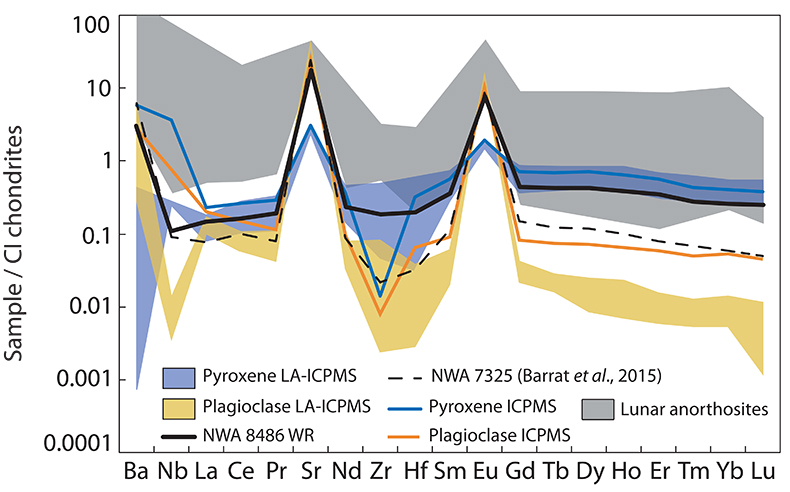
Figure 1 Trace element composition of NWA 8486 normalised to CI chondrites (Anders and Grevesse, 1989
Anders, E., Grevesse, N. (1989) Abundances of the elements: Meteoritic and solar. Geochimica et Cosmochimica Acta 53, 197-214.
). All fractions exhibit Eu and Sr positive anomalies. NWA 7325 has a lower content for most incompatible elements compared to NWA 8486 owing to its modal enrichment in plagioclase. Lunar anorthosites are reported for comparison (data from Haskin et al., 1973Haskin. L. A., Helmke P. A., Blanchard D. P., Jacobs J. W., Telander K. (1973) Major and trace elements abundances in samples from lunar highlands. Proceedings of the Lunar Science Conference 4, 1275-1296.
and Norman et al., 2003Norman, M.D., Borg, L.E., Nyquist, L.E., Bogard, D.D (2003) Chronology, geochemistry, and petrology of a ferroan noritic anorthosite clast from Descartes breccia 67215: Clues to the age, origin, structure, and impact history of the lunar crust. Meteoritics and Planetary Science 38, 645-661.
).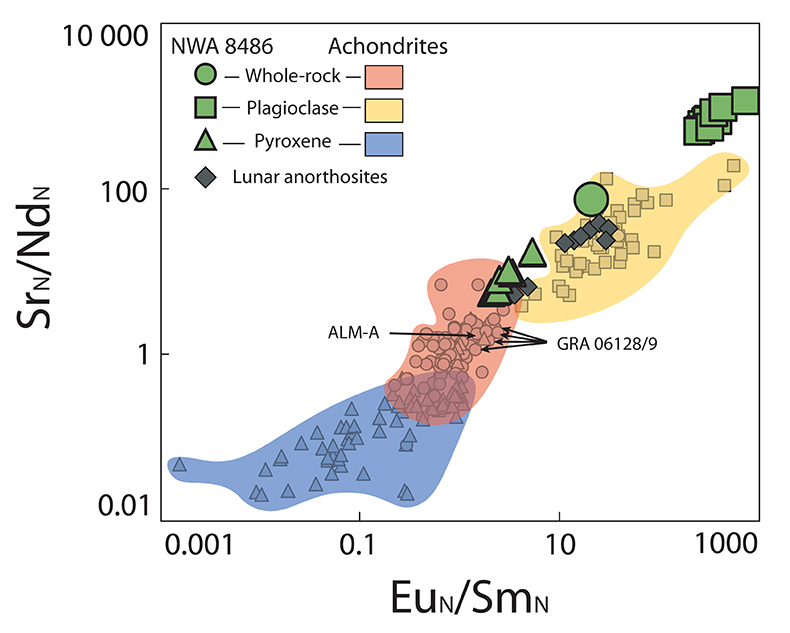
Figure 2 Eu/Sm and Sr/Nd ratios of achondrites and NWA 8486 normalised to CI chondrites (Anders and Grevesse, 1989
Anders, E., Grevesse, N. (1989) Abundances of the elements: Meteoritic and solar. Geochimica et Cosmochimica Acta 53, 197-214.
). Overlap between the different fields is due to whole rocks mainly composed of pyroxene or plagioclase (e.g., aubrites, ureilites, lunar anorthosites). For each field group, NWA 8486 exhibits higher EuN/SmN and SrN/NdN. Only lunar anorthosites are similar to NWA 8486 whole rock, but they contain much more plagioclase than NWA 8486. See Supplementary Information for data sources.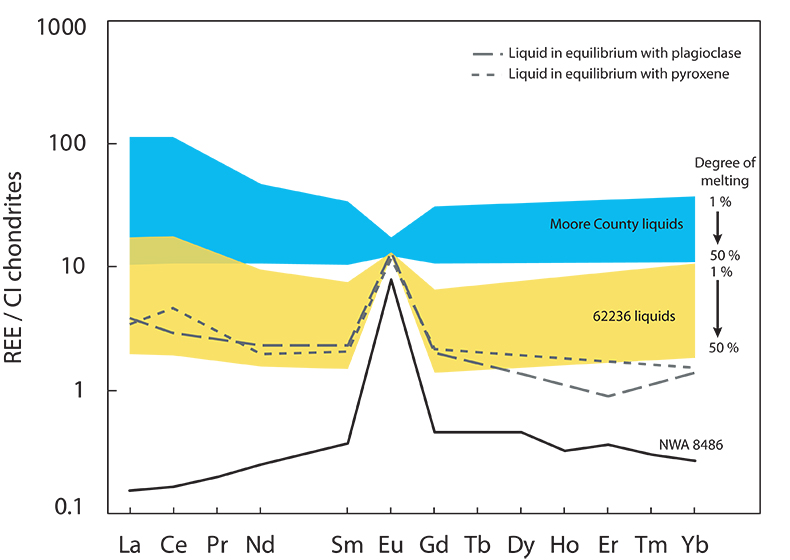
Figure 3 REE composition of liquids in equilibrium with NWA 8486 minerals (in grey dashed lines) compared to liquids modelled with compositions of the cumulate eucrite Moore County and the pyroxene-rich lunar anorthosite Apollo 62236, normalised to CI chondrites (Anders and Grevesse, 1989
Anders, E., Grevesse, N. (1989) Abundances of the elements: Meteoritic and solar. Geochimica et Cosmochimica Acta 53, 197-214.
). A non-modal melting is considered, in agreement with petrological constraints, of eutectic proportions of 42 % plagioclase and 58 % pyroxene (Osborn, 1942Osborn, E.F. (1942) The system CaSiO3-diopside-anorthite. American Journal of Science 240, 751-788.
). The range of composition of the liquids from 1 % to 50 % degree of melting is represented for each source composition. NWA 8486 whole rock composition is shown (black line) for comparison. See Supplementary Information for details on the model.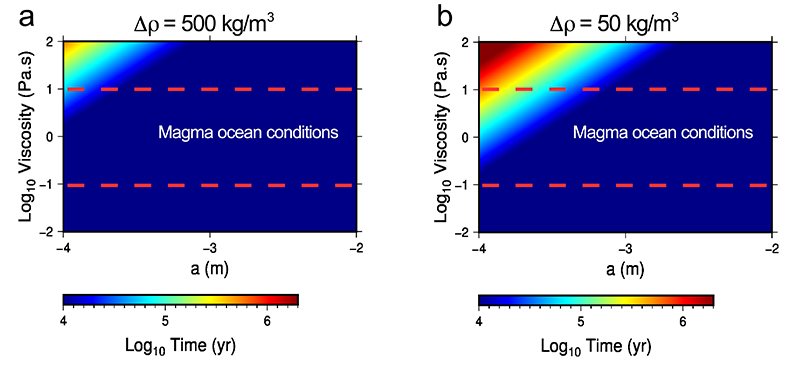
Figure 4 Time for plagioclase crystal ascent during the late stage of a magma ocean. This time is calculated for a range of viscosities (0.1 to 10 Pa.s), crystal diameters (a; 100 µm to 1 cm) and density contrasts (∆ρ; 50 to 500 kg/m3) between the crystal and the liquid phase. The time for a crystal to reach the surface of the magma ocean is represented with a colour scale ranging between 10 kyr (blue) and 2 Myr (red). Both panels show that the time of ascent of the crystal is a few tens of thousands of years in magma ocean conditions, except for small crystals around 100 µm and high viscosities of >10 Pa.s for which time of ascent is longer.






